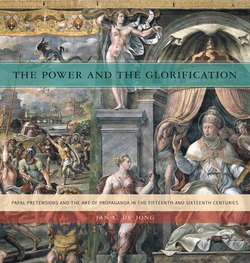The Power and the Glorification

Реклама. ООО «ЛитРес», ИНН: 7719571260.
Оглавление
Jan L. de Jong. The Power and the Glorification
Отрывок из книги
THE POWER AND THE GLORIFICATION
PAPAL PRETENSIONS AND THE ART OF PROPAGANDA IN THE FIFTEENTH AND SIXTEENTH CENTURIES
.....
Index
The Stanza d’Eliodoro frescoes, painted shortly afterwards by Raphael in the Vatican Palace, are certainly related to these events, but again the allusions to current issues are put in general terms. In 1508, the still relatively unknown Raphael had taken on the commission to decorate one of the rooms of the papal apartment, what is known as the Stanza della Segnatura. This room probably served as the pope’s library, and the paintings accordingly show famous authors and scholars from all ages (fig. 14). They astounded the pope so much that he immediately ordered Raphael to continue and decorate the adjoining Stanza d’Eliodoro. In all likelihood, this room was an audience chamber, and thus subjects with a more political content were chosen. Begun in 1511, the frescoes on the four walls show instances of divine intervention (fig. 15);21 in all four scenes a pope is shown as present, even if the story itself does not require him or his presence is downright anachronistic. In the first fresco, three heavenly creatures, in answer to the Jewish high priest Onias’s prayer for help, drive out Heliodorus trying to rob the temple treasury (fig. 16).22 A pope is miraculously included as an eyewitness to this episode from the Old Testament. In the second fresco, an angel liberates Saint Peter from prison (fig. 17).23 In the third fresco, Saints Peter and Paul appear in the sky to assist Pope Leo I in deterring Attila and his Huns from advancing to Rome in 452 (fig. 18). In the final fresco, representing a miracle that took place at Bolsena in 1263, the communion wafer exudes real blood, releasing the celebrating priest from his doubts about the question whether the eucharistic transformation really changes the host into the body of Christ (fig. 19). A pope appears here too, though none was present when the miracle occurred. The relevance of these four events for the current pope has been highlighted by giving the painted pontiffs (except Saint Peter himself) the facial traits of Julius II and his successor Leo X, who continued the decoration project after Julius’s death.
.....